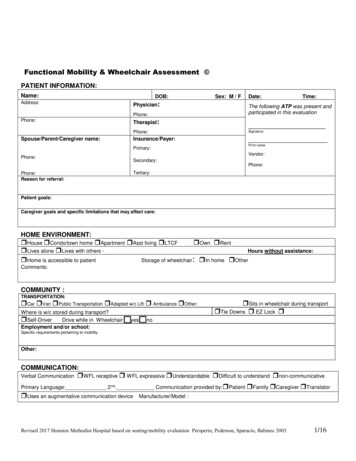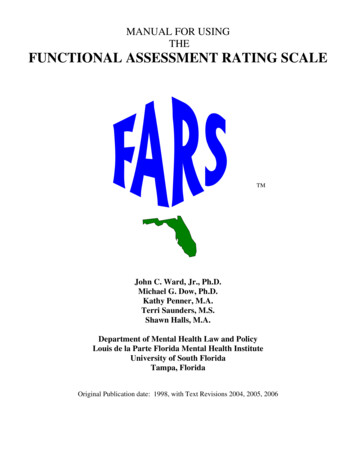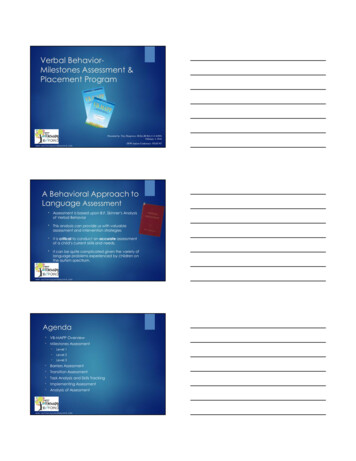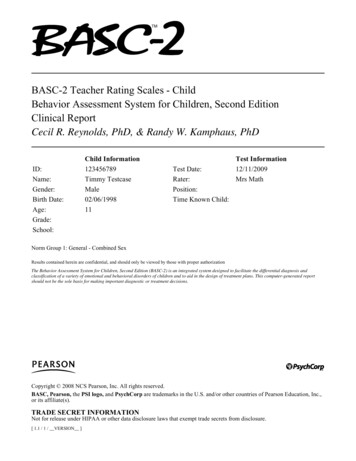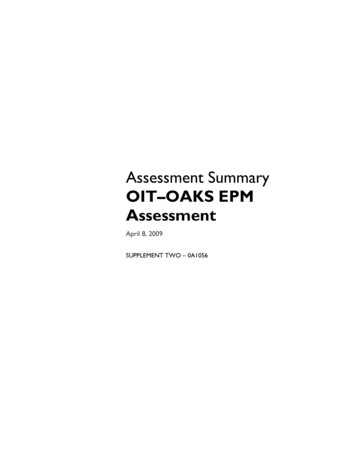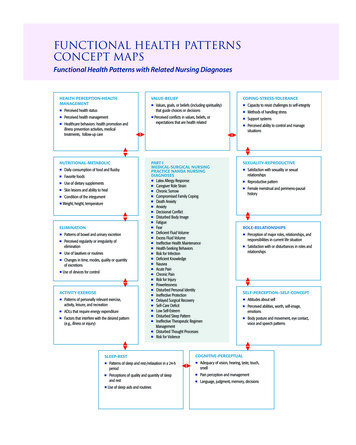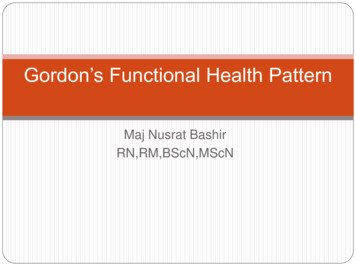
Transcription
Functional BehaviorAssessment (FBA)Functional Behavior Assessment (FBA)---EBP Brief Packet---Components of the EBP Brief Packet This overviewbrief willsupport youruse of theevidencebased practice:FunctionalBehaviorAssessment.For moreinformation visit:8.Sam, A., & AFIRM Team. (2015). Functional behavior assessment. Chapel Hill, NC:National Professional Development Center on Autism Spectrum Disorder,FPG Child Development Center, University of North Carolina. Retrievedfrom smentwww.afirm.fpg.unc.eduFunctional Behavior AssessmentNational Professional Development Center on ASD201611 of 31
Functional BehaviorAssessment (FBA)What is Functional Behavior Assessment?At times, all children and youth can struggle with challenging behavior. If a challenging behaviorinterferes with the learner’s ability to learn, then a functional behavior assessment (FBA) isneeded. FBA can be used when the intensity, duration, or type of interfering behavior createssafety concerns or impacts a child’s development. An FBA assists the IEP team in understandingthe function or purpose of a specific interfering behavior. Data collection is an essentialcomponent of FBA.Evidence-baseBased upon the recent review, functional behavior assessment meets the evidence-basedpractice criteria set by NPDC with 10 single case design studies. The practice has been effectivewith learners in early intervention (0-2 years) to high school (15-22 years). Evidence-basedpractices (EBP) and studies included in the 2014 EBP report detailed how FBA can be usedeffectively to address: academic, adaptive, behavior, communication, and school readinessoutcomes.How is FBA Being Used?Functional behavior assessment can be used by a variety of professionals, including teachers,special educators, therapists, paraprofessionals, and early interventionists in educational andcommunity-based environments.For moreinformation visit:www.afirm.fpg.unc.eduFunctional Behavior AssessmentNational Professional Development Center on ASD201622 of 31
Functional BehaviorAssessment (FBA)---Evidence-base for FunctionalBehavior Assessment--The National Professional Development Center on ASD has adopted the following criteria to determine if apractice is evidence-based. The EBP Report provides more information about the review process (Wong etal., 2014).Efficacy must be established through high quality, peer-reviewed research in scientific journals using: randomized or quasi-experimental design studies (two high quality experimental or quasiexperimental group design studies), single-subject design studies (three different investigators or research groups must haveconducted five high quality single subject design studies), or combination of evidence [one high quality randomized or quasi-experimental group design studyand three high quality single subject design studies conducted by at least three differentinvestigators or research groups (across the group and single subject design studies)].--OVERVIEW-Functional behavior assessment is used to understand the function or purpose of a specific interferingbehavior. Functional behavior assessment meets the evidence-based practice criteria with 10 single casedesign studies. The practice has been effective with learners in early intervention (0-2 years) to high school(15-22 years). Studies included in the 2014 EBP report detailed how functional behavior assessment can beused effectively to address: academic, adaptive, behavior, communication, and school readiness outcomes.In the table below, the outcomes identified by the evidence base are shown by age of participants.Early dinessSchool-ReadinessAdaptiveAcademicFunctional Behavior AssessmentAcademicNational Professional Development Center on ASD20151 3 of 31
Functional BehaviorAssessment (FBA)Early intervention (0-2 Years)* Dunlap, G., & Fox, L. (1999). A demonstration of behavioral support for young children with autism. Journal of PositiveBehavior Interventions, 1(2), 77-87. doi: 10.1177/109830079900100202Preschool (3-5 years)Blair, K. C., Lee, I., Cho, S., & Dunlap, G. (2011). Positive behavior support through family-school collaboration for youngchildren with autism. Topics in Early Childhood Special Education, 31, 22-36. doi: 10.1177/0271121410377510* Dunlap, G., & Fox, L. (1999). A demonstration of behavioral support for young children with autism. Journal of PositiveBehavior Interventions, 1(2), 77-87. doi: 10.1177/109830079900100202* Kodak, T., Fisher, W. W., Clements, A., Paden, A. R., & Dickes, N. R. (2011). Functional assessment of instructional variables:Linking assessment and treatment. Research in Autism Spectrum Disorders, 5(3), 1059-1077. doi:10.1016/j.rasd.2010.11.012Lucyshyn, J. M., Albin, R. W., Horner, R. H., Mann, J. C., Mann, J. A., & Wadsworth, G. (2007). Family implementation of positivebehavior support for a child with autism: Longitudinal, single-case, experimental, and descriptive replication andextension. Journal of Positive Behavior Interventions, 9, 131-150. doi: 10.1177/10983007070090030201Elementary (6-11 years)Blair, K. S. C., Umbreit, J., Dunlap, G., & Jung, G. (2007). Promoting inclusion and peer participation through assessmentbased intervention. Topics in Early Childhood Special Education, 27(3), 134-147. doi:10.1177/02711214070270030401Devlin, S., Leader, G., & Healy, O. (2009). Comparison of behavioral intervention and sensory-integration therapy in thetreatment of self-injurious behavior. Research in Autism Spectrum Disorders, 3(1), 223-231. doi:10.1016/j.rasd.2008.06.004* Kodak, T., Fisher, W. W., Clements, A., Paden, A. R., & Dickes, N. R. (2011). Functional assessment of instructional variables:Linking assessment and treatment. Research in Autism Spectrum Disorders, 5(3), 1059-1077. doi:10.1016/j.rasd.2010.11.012McComas, J., Hoch, H., Paone, D., & El‐Roy, D. (2000). Escape behavior during academic tasks: A preliminary analysis ofidiosyncratic establishing operations. Journal of Applied Behavior Analysis, 33(4), 479-493. doi: 10.1901/jaba.2000.33479Roberts-Gwinn, M. M., Luiten, L., Derby, K. M., Johnson, T. A., & Weber, K. (2001). Identification of competing reinforcers forbehavior maintained by automatic reinforcement. Journal of Positive Behavior Interventions, 3(2), 83-87. doi:10.1177/109830070100300204Middle (12-14 years)Clarke, S., Worcester, J., Dunlap, G., Murray, M., & Bradley-Klug, K. (2002). Using multiple measures to evaluate positivebehavior support: A case example. Journal of Positive Behavior Interventions, 4(3), 131-145. doi:10.1177/10983007020040030201High (15-22 years)O'Reilly, M. F., Edrisinha, C., Sigafoos, J., Lancioni, G., & Andrews, A. (2006). Isolating the evocative and abative effects of anestablishing operation on challenging behavior. Behavioral Interventions, 21(3), 195-204. doi: 10.1002/bin.215* Research which included participants in multiple age ranges.Functional Behavior AssessmentNational Professional Development Center on ASD20152 4 of 31
Functional Behavior Assessment (FBA)---Step-by-Step Guide--BEFORE YOU START This practice guideoutlines how to planfor, use, and monitorthe practice offunctional behavioralassessment.Keep in mind thatFBA can be used todecreaseinappropriatebehaviors andincrease appropriatebehaviors.Each of the following points is importantto address so that you can be sure the selected EBPis likely to address the learning needs of yourstudent.Have you found out more information about. . .? Identified the behavior Collected baseline data through directobservation Established a goal or outcome that clearlystates when the behavior will occur,what the target skill is, and how theteam will know when the skill ismastered If the answer to any of these is “no,” review theprocess of how to select an EBP.For more information visit:www.afirm.fpg.unc.eduFunctional Behavior AssessmentNational Professional Development Center on ASD201515 of 31
Now you are ready to start Step 1: FBA PlanningThe planning step explains initial steps and considerations involved to prepare for and develop an FBA for a learner.Identify one person as the FBA coordinator who will coordinate and manage data collection, answer questions fromother team members, and make sure that the FBA is implemented as intended.1.1 Establish a multidisciplinary teamPlanning should begin with forming a multidisciplinary team that includes all individuals who have observedthe learner exhibiting the interfering behavior.1.2 Identify and define interfering behaviorTogether, the team identifies the interfering behavior that is most problematic for the learner. Any behaviorsthat create safety concerns for the learner or others should be addressed first.1.3 Review records of learnerIn order to understand the selected interfering behavior, records should be reviewed (medical records,psychological evaluations, educational testing, Individualized Education Program (IEP) or Individual FamilyService Plan (IFSP), incident reports, anecdotal notes, etc.)1.4 Select assessment proceduresTeam members will gather information concerning the behavior from formal/informal interviews andstandardized behavior rating scales.1.5 Develop plan for collecting dataData will need to be collected during times and settings where the interfering behavior occurs most often.Also, it is important to sample in other locations or at other times where the behavior might not occur. Datacollection should be for a sufficient period of time to identify consistencies in the behavior.Use the FBA Planning Sheet as a companion for completing the planning step.Functional Behavior AssessmentNational Professional Development Center on ASD201526 of 31
Functional Behavior AssessmentSTEP-BY-STEPStep 2: Using FBAThis section describes the process of implementing the FBA plan that was developed.2.1 Collect data using selected assessment proceduresDuring the planning stage, the team selected several assessment tools and/or interviews. These will need tobe administered and data collected.2.2 Collect data on the occurrence of interfering behaviorFollowing the developed plan, the team collects data on the interfering behavior using direct observationmethods. Using A-B-C data charts will help team members determine what happens right before thebehavior (the antecedent), when the behavior that occurs (behavior), and what happens directly after thebehavior (the consequence). Also, data tables (commonly referred to as scatterplots in the FBA literature) canbe used for data collection in order to help team members determine when the behavior is occurring, thepossible functions of the behavior, and times of the day when an intervention might be implemented toreduce the interfering behavior.Use the ABC Data Chart to understand the antecedent, behavior, and consequence.Use the FBA Data Table and Anecdotal Note form to identify patterns.2.3 Analyze collected dataAnalyze collected data to determine the function of the behavior. Behaviors typically fall into two categories offunction: 1) to get or obtain something desired or 2) to escape or avoid.2.4 Develop a hypothesis statementBased upon the information gathered through assessments, interviews, and direct observations, the teamdevelops a hypothesis statement. Be sure the hypothesis statement developed includes:1) the setting events, immediate antecedents, and immediate consequences that surround theinterfering behavior,2) a restatement and refinement of the description of the interfering behavior that is occurring, and3) the function the behavior serves (i.e., get/obtain, escape/avoid).Use the FBA Analysis and Hypothesis Form to develop a hypothesis statement.2.5 Test the hypothesis to ensure it is correctTo test the developed hypothesis, modify the setting/activity to increase the probability that the behavioroccurs. Testing can occur over several days or weeks to confirm the cause of the interfering behavior.Functional Behavior AssessmentNational Professional Development Center on ASD201537 of 31
Functional Behavior AssessmentSTEP-BY-STEPStep 2: Using FBA (continued)2.6 Identify appropriate EBPs to address the interfering behaviorWhen team members understand the function of the behavior, evidence-based practices can beimplemented to reduce the occurrence of the identified interfering behavior while increasing appropriatebehaviors.2.7 Develop behavior intervention planAfter an EBP is identified, the team develops a behavior intervention plan. The BIP should include strategiesfor the following:1) preventing the occurrence of the interfering behavior,2) teaching or increasing the replacement behavior, and3) increasing learning opportunities and social engagement.Use the Guide to Planning Behavior Intervention Plan develop the BIPFunctional Behavior AssessmentNational Professional Development Center on ASD201548 of 31
Functional Behavior AssessmentSTEP-BY-STEPStep 3: Monitoring FBAThe following process describes how the use of FBA can be monitored and how the plan might need to be adjustedbased on the data.3.1 Collect and analyze data on interfering behaviorTeam members need to collect data that focus on:1) the frequency, or how often, the behavior occurs using time sampling or event sampling,2) how long (duration) the interfering behavior lasts when it occurs, and3) frequency of use of replacement behavior(s) including how often the leaner uses the replacedbehavior(s).Use the FBA Time Sampling Form to monitor the frequency of the behavior.Use the FBA Event Sampling Form to monitor the frequency of behaviors that are low frequency.Use the FBA Duration Behavior Form to monitor how long a behavior lasts.Use the Replacement Behavior Form to monitor strategies and interventions.3.2 Determine next steps based on learner progressCollecting data will help team members deter
21.12.2015 · Functional behavior assessment is used to understand the function or purpose of a specific interfering behavior. Functional behavior assessment meets the evidence-based practice criteria with 10 single case design studies. The practice has been effective with learners in early intervention (0-2 years) to high school (15-22 years). Studies included in the 2014 EBP report detailed how functional behavior
